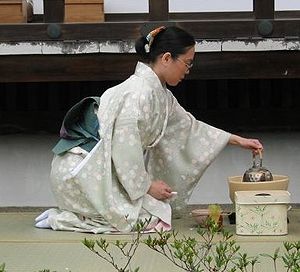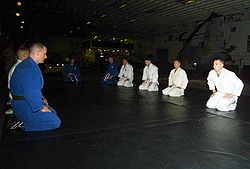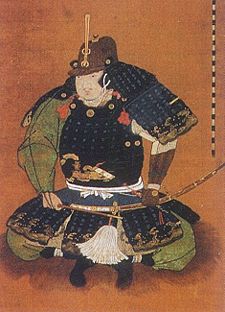
Seiza
Encyclopedia

Japanese language
is a language spoken by over 130 million people in Japan and in Japanese emigrant communities. It is a member of the Japonic language family, which has a number of proposed relationships with other languages, none of which has gained wide acceptance among historical linguists .Japanese is an...
term for the traditional formal way of sitting
Sitting
Sitting is a rest position supported by the buttocks or thighs where the torso is more or less upright.- Sitting on the floor :The most common way of sitting on the floor involves bending the knees...
in Japan
Japan
Japan is an island nation in East Asia. Located in the Pacific Ocean, it lies to the east of the Sea of Japan, China, North Korea, South Korea and Russia, stretching from the Sea of Okhotsk in the north to the East China Sea and Taiwan in the south...
.
Form
To sit seiza-style, one first kneels on the floor, folding one's legs underneath one's thighs, while resting the buttocks on the heelHeel
In human anatomy, the heel is the prominence at the posterior end of the foot. It is based on the projection of one bone, the calcaneus or heel bone, behind the articulation of the bones of the lower leg.- Human anatomy :...
s. The ankles are turned outward as the tops of the feet are lowered so that, in a slight "V" shape, the tops of the feet are flat on the floor and big toes are overlapped, and the buttocks are finally lowered all the way down. Depending on the circumstances, the hands are folded modestly in the lap, or are placed palm down on the upper thighs with the fingers close together, or are placed on the floor next to the hips, with the knuckles rounded and touching the floor. The back is kept straight, though not unnaturally stiff. Traditionally, women sit with the knees together while men separate them slightly. Some martial arts, notably kendō
Kendo
, meaning "Way of The Sword", is a modern Japanese martial art of sword-fighting based on traditional Japanese swordsmanship, or kenjutsu.Kendo is a physically and mentally challenging activity that combines strong martial arts values with sport-like physical elements.-Practitioners:Practitioners...
, aikidō
Aikido
is a Japanese martial art developed by Morihei Ueshiba as a synthesis of his martial studies, philosophy, and religious beliefs. Aikido is often translated as "the Way of unifying life energy" or as "the Way of harmonious spirit." Ueshiba's goal was to create an art that practitioners could use to...
, and iaidō
Iaido
is a modern Japanese martial art associated with the smooth, controlled movements of drawing the sword from its scabbard, striking or cutting an opponent, removing blood from the blade, and then replacing the sword in the scabbard...
, may prescribe up to two fist widths of distance between the knees.
Stepping into and out of seiza is mindfully performed. There are codified traditional methods of entering and exiting the sitting position depending on occasion and type of clothing worn.
History
Through the early history of Japan, various ways of sitting were regarded as 'proper', such as sitting cross-legged, sitting with one knee raised, or sitting to the side. People's social circumstances, clothing styles, and the places where they sat naturally brought about their manners of sitting. The development, in the Muromachi period, of Japanese architecture in which the floors were completely covered with tatamiTatami
A is a type of mat used as a flooring material in traditional Japanese-style rooms. Traditionally made of rice straw to form the core , with a covering of woven soft rush straw, tatami are made in standard sizes, with the length exactly twice the width...
(thick straw mats), combined with the strict formalities of the ruling warrior class for which this style of architecture was principally designed, heralded the adoption of the sitting posture known today as seiza as the respectful way to sit. However, it probably was not until around the years surrounding the turn of the 18th century (the Genroku to Kyōhō eras in Japanese history) that the Japanese generally adopted this manner of sitting in their everyday lives. In present-day Japan, traditional-style tatami-floored rooms, and circumstance where one should sit 'properly' in this manner on the tatami/floor, have become uncommon, and many people in Japan are consequently unaccustomed to sitting seiza.
Floor
Seiza involves sitting down on the floor and not on a chair of some sort. In traditional Japanese architecture, floors in various rooms designed for comfort have tatamiTatami
A is a type of mat used as a flooring material in traditional Japanese-style rooms. Traditionally made of rice straw to form the core , with a covering of woven soft rush straw, tatami are made in standard sizes, with the length exactly twice the width...
floors. Seiza thus is closely connected with tatami flooring. There are circumstances, however, when people sit seiza-style on carpeted and hardwood floors. In many martial arts, for instance, this sitting position generally takes place on hardwood floors. Depending on the formality of the occasion, the setting, and the relative status of the person, it is sometimes acceptable to sit on a special cushion called a zabuton
Zabuton
A zabuton is a Japanese cushion for sitting. The zabuton is generally used when sitting on the floor, and may also be used when sitting on a chair. Ordinarily any place in Japan where seating is on the floor will be provided with zabuton, for sitting comfort...
(座布団, literally a "sitting futon
Futon
Futon is an English word derived from Japanese , a term generally referring to the traditional style of Japanese bedding consisting of padded mattresses and quilts pliable enough to be folded and stored away during the day, allowing the room to serve for purposes other than as a bedroom...
").
Difficulties
Sometimes stools are provided for elderly or injured people even when others are expected to sit seiza-style. It is advisable, particularly in formal situations, to at least try to sit seiza-style. Non-Japanese who have not grown up sitting in this posture may, however, have difficulty assuming it at all. Those unfamiliar with seiza will likely find that maintaining it for more than a minute or two tends to lead to loss of circulation, with the accompanying 'pins and needles' feeling, followed by painful burning sensations, and then eventually complete numbness in the legs. However, the physical discomfort lessens with experience as the circulation of the blood improves. Experienced seiza practitioners can maintain the posture for forty minutes or more with minimal discomfort. Certain knee problems are greatly agitated when assuming this position, specifically Osgood-Schlatter disease.Special seiza stools are available in Japan. They are folding stools, small enough to be carried in a handbag, which are placed between the feet and on which one rests the buttocks when sitting seiza-style. They allow one to maintain the appearance of sitting seiza while discreetly taking pressure off the heels and feet.
Use in traditional arts

Japanese tea ceremony
The Japanese tea ceremony, also called the Way of Tea, is a Japanese cultural activity involving the ceremonial preparation and presentation of matcha, powdered green tea. In Japanese, it is called . The manner in which it is performed, or the art of its performance, is called...
, although a table-style version of tea ceremony known as ryūrei was invented in the 19th century. Seiza is also the traditional way of sitting while doing other arts such as shodo
Shodo
"Shōdō" is the fortieth single by B'z, released on January 25, 2006. This song is one of B'z many number-one singles in Oricon charts. This song was the opening theme of Case Closed.- External links :*...
(calligraphy) and ikebana
Ikebana
is the Japanese art of flower arrangement, also known as .-Etymology:"Ikebana" is from the Japanese and . Possible translations include "giving life to flowers" and "arranging flowers".- Approach :...
(flower arranging), though with the increasing use of western-style furniture it is not always necessary nowadays.
Many theatres for traditional performing arts such as kabuki
Kabuki
is classical Japanese dance-drama. Kabuki theatre is known for the stylization of its drama and for the elaborate make-up worn by some of its performers.The individual kanji characters, from left to right, mean sing , dance , and skill...
still have audience seating sections where the spectators sit in seiza style.
Shikkō
Walking on the feet and knees while in the seiza posture, known as , is considered more polite than standing up and walking regularly. Shikkō is today quite rare, but is found in some traditional formal restaurants and ryokan, and is practiced in the martial art of aikidōAikido
is a Japanese martial art developed by Morihei Ueshiba as a synthesis of his martial studies, philosophy, and religious beliefs. Aikido is often translated as "the Way of unifying life energy" or as "the Way of harmonious spirit." Ueshiba's goal was to create an art that practitioners could use to...
, where practitioners learn to fight while moving in shikkō.
To perform this knee-walking movement correctly the heels must be kept close together, and the body must move as a whole unit. It is because movement in shikkō forces one to engage the hips that it is considered valuable for aikidō training.

Agura
Sitting cross-legged, , is considered informal: it is appropriate for certain situations but not others. It is common in informal situations, such as eating at a low table in a casual restaurant, and allowed in formal situations especially for those for whom seiza is difficult, such as elderly or non-Japanese people.Sitting cross-legged is generally considered uncouth for women, and female informal sitting has both legs off to one side, with one side of the hips on the floor.
Kiza
To sit in seiza requires coming to a kneeling position momentarily, with the heels propped up; if one remains seated on the heels with the balls of the feet touching the floor and toes flexed forward, it is called . If one then lowers the tops of the feet to the floor, one then will be in the seiza position. Kiza could be translated as "dangerous sitting", as the bodyweight creates a flexion on the feet which is considered harmful. In iaidoIaido
is a modern Japanese martial art associated with the smooth, controlled movements of drawing the sword from its scabbard, striking or cutting an opponent, removing blood from the blade, and then replacing the sword in the scabbard...
, practitioners stand up to draw the sword
Katana
A Japanese sword, or , is one of the traditional bladed weapons of Japan. There are several types of Japanese swords, according to size, field of application and method of manufacture.-Description:...
and cut after momentarily assuming kiza, so as not to sprain the instep jumping up directly from seiza.
External links
- SEIZA No Kamae Tutorial (Japanese Martial Arts)
- The Proprieties of Sitting
- Make Your Own Seiza

